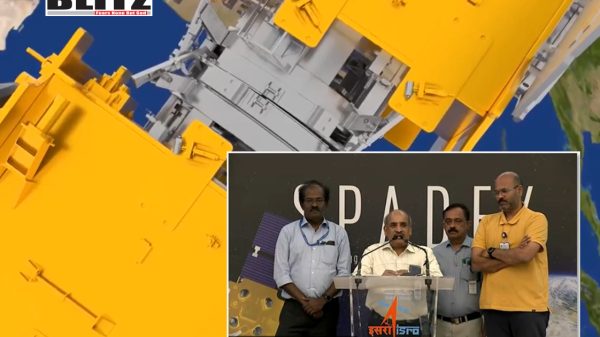India joins elite club with successful space docking milestone
- Update Time : Friday, January 17, 2025

The Indian Space Research Organization (ISRO) has achieved yet another historic milestone, marking a significant leap in the country’s space exploration capabilities. On January 16, India became the fourth nation to successfully complete an unmanned space docking with its Space Docking Experiment (SpaDeX) mission. This accomplishment lays the groundwork for ambitious projects such as the construction of a homegrown space station and the possibility of sending an Indian astronaut to the Moon by 2040.
ISRO’s announcement on the social media platform X (formerly Twitter) captured the excitement and pride of the nation: “Spacecraft docking successfully completed! A historic moment.” The SpaDeX mission was initially launched on December 30, with its primary objective to develop and demonstrate the complex technologies required for rendezvous, docking, and undocking of two small spacecraft in a low-Earth orbit.
The docking itself occurred just days after a critical trial run on January 12. During the trial, the two spacecraft were brought within three meters of each other before being safely maneuvered back to a secure distance. This success showcases ISRO’s capability in precise maneuvering and advanced control systems, which are essential for docking operations in space.
The successful execution of SpaDeX is pivotal for India’s future space endeavors. ISRO described the mission as a “cost-effective technology demonstrator” that is integral to achieving the nation’s broader space ambitions. Among these goals are the retrieval of lunar samples, establishing a sustainable space station, and sending an Indian astronaut to the Moon within the next two decades.
Prime Minister Narendra Modi, a staunch supporter of India’s space program, commended ISRO’s achievement. “Congratulations to our scientists at @isro and the entire space fraternity for the successful demonstration of space docking of satellites. It is a significant stepping stone for India’s ambitious space missions in the years to come,” he stated in a congratulatory post on X. The Prime Minister’s words underline the growing importance of space exploration as a key element of India’s technological and strategic growth.
Docking technology is a cornerstone of modern space exploration and operations. It enables the assembly of large structures in orbit, such as space stations, by connecting various modules. Additionally, docking facilitates the transfer of crew, equipment, and supplies between modules or visiting spacecraft, ensuring the functionality and sustainability of a space station.
The SpaDeX mission utilized advanced in-space docking technology, which requires high precision and robust control systems to connect two spacecraft in orbit seamlessly. This technology also has applications beyond space stations, including satellite servicing. By enabling the repair and refueling of satellites, docking technology can significantly extend the operational lifespans of these costly assets. Such advancements align with ISRO’s commitment to developing cost-effective and sustainable solutions for space exploration.
The successful SpaDeX mission adds to a series of achievements by ISRO in recent years. In 2023 alone, the space agency completed multiple satellite launches and made significant progress on other groundbreaking projects. These included testing the Reusable Launch Vehicle (RLV) technology and initiating the assembly of the Human Rated Launch Vehicle Mark-3 (HLVM3). The HLVM3 will serve as the launch vehicle for Gaganyaan, India’s maiden human spaceflight mission.
The SpaDeX mission is just one piece of ISRO’s broader vision for the future. The agency has set its sights on several ambitious projects, including sending Indian astronauts to the Moon and developing a fully operational space station by 2040.
India’s lunar ambitions were highlighted during the Chandrayaan-3 mission, which successfully landed a rover on the Moon’s surface. Building on this success, ISRO aims to retrieve lunar samples in future missions, contributing valuable scientific data to global lunar exploration efforts. The docking technology demonstrated in the SpaDeX mission will be crucial for these endeavors, as it enables the assembly and maintenance of spacecraft in orbit, as well as potential docking with other lunar modules.
India’s achievements in space exploration are not just a matter of national pride but also a testament to its growing stature on the global stage. By becoming the fourth country to master space docking technology, India joins an elite group of nations-the United States, Russia, and China-that have demonstrated this capability.
This accomplishment is expected to bolster India’s position as a leading player in the global space industry. With its emphasis on cost-effective and innovative solutions, ISRO has already earned international recognition. The agency’s success in launching satellites for multiple countries and its low-cost Mars Orbiter Mission (Mangalyaan) have set benchmarks in the industry. The SpaDeX mission further reinforces India’s reputation as a reliable and resourceful spacefaring nation.
The success of the SpaDeX mission is likely to inspire a new generation of scientists, engineers, and space enthusiasts in India. As the country invests in advanced technologies and ambitious projects, it creates opportunities for collaboration, innovation, and skill development. Educational institutions and research organizations across India are expected to benefit from the growing focus on space exploration, fostering a culture of scientific inquiry and innovation.
While the SpaDeX mission marks a significant achievement, it is only the beginning of a long journey for India’s space program. The development and operation of a space station will require sustained investment, technological advancements, and international collaboration. Additionally, the ambitious goal of sending an Indian astronaut to the Moon by 2040 will involve overcoming numerous challenges, including the development of advanced life support systems, propulsion technologies, and deep-space communication capabilities.
However, if ISRO’s track record is any indication, the agency is well-equipped to tackle these challenges. With a history of delivering high-impact projects within tight budgets, ISRO has demonstrated its ability to achieve the seemingly impossible. The success of the SpaDeX mission is a testament to the agency’s ingenuity, perseverance, and commitment to advancing India’s space ambitions.
India’s successful docking of the SpaDeX satellites represents a landmark achievement in the country’s space exploration journey. By mastering docking technology, ISRO has taken a crucial step toward realizing its vision of a self-sufficient and advanced space program. This accomplishment not only enhances India’s capabilities in space exploration but also positions the nation as a key player in the global space community.
As India continues to push the boundaries of what is possible, the SpaDeX mission serves as a powerful reminder of the country’s potential to achieve greatness. With a clear vision, unwavering determination, and a commitment to innovation, India is poised to reach new heights in its quest to explore the final frontier.













Leave a Reply